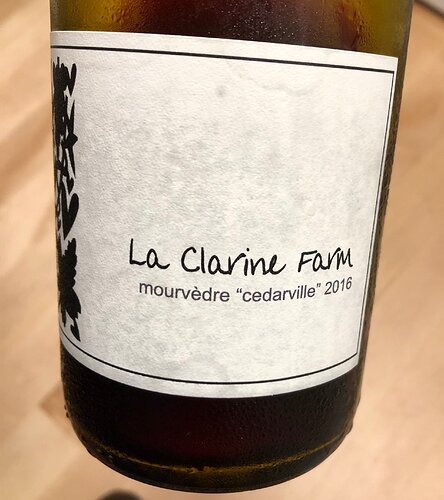I tend to be sympathetic to less interventional winemaking, but this no-sulfur theology drives me nuts. The notion is that with low or no sulfur, the grapes and terroir will show through.
The only problem is when the wines, instead, are overwhelmed by some biological nastiness. Then all natural wines start to taste alike.
A case in point: I’m in Upstate New York this week, in an area that’s a bit of a wine retail wasteland. In a store in that has almost no wine I’d want to buy, I spotted the 2016 La Clarine Farm - Mourvedre - Cedarville. Chambers Street hosted a tasting of La Clarine wines a couple of years ago and I liked their albarino and I bought a bottle of their tempranillo, which seemed promising. So, when I spotted the La Clarine among the rather grim offerings yesterday, I grabbed it. I’m always interested to try Sierra Foothills wines, and this was 12.7% ABV, so that was intriguing, too.
Sad to say, it was fairly funky on opening, and a bit weird and bitter on tasting. Not at all pleasant. Then there was a bit of mousiness at the back – the telltale tipoff that a wine was made without added sulphites. (It’s a byproduct of lactobacillus.)
My guests took small sips and went back to the white. I put the rest of the bottle in refrigerator. Tonight the mousiness was overwhelming and the wine was extremely volatile, in a really nasty way. This was not “lifted” but solvent-like. (A thorough rinsing did not remove the mousiness. I had to rewash the glass. It was more tenacious than any TCA.)
FYI, this was bottled under screwcap, so this isn’t case of oxygen exposure through a flawed cork.
The winery’s website explains the philosophy:
Why was everyone automatically adding SO2 at the crusher, and then at every racking? … Textbooks will give you good reasons to do these things. But textbooks are also concerned with merely making “sound” wine. I wanted more than that.
A more sensible person than I would have moved ahead slowly, experimenting perhaps with using less sulfur one year, maybe with a batch or two with “wild” yeasts. Not me. I decided to throw all those things out, at once, and start at zero.
No added yeasts. No SO2 at the crusher unless there is a good reason to do so. … No SO2 addition at any point in the process unless I needed to. …
But I wasn’t going to do any of that stuff either. If I really screwed up, it would just go down the drain…
I don’t want to pick on a small winery where the wines are plainly made with passion and commitment.
But the answer to the question of why people add sulfur is so that wines don’t turn out like this. So they are, at a minimum, sound. And so consumers like me don’t have to pour a $32 wine down the drain.
Sorry. Rant over. You may continue.
